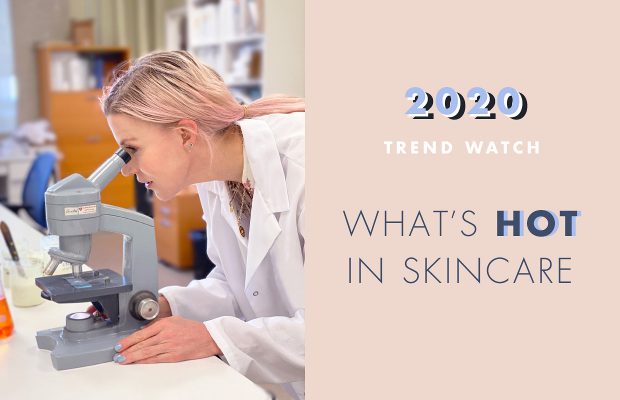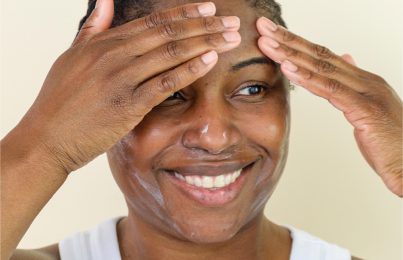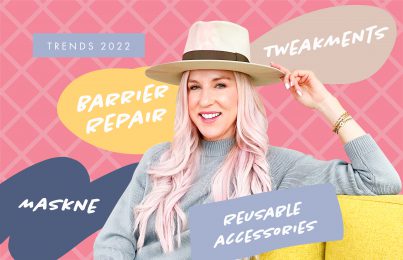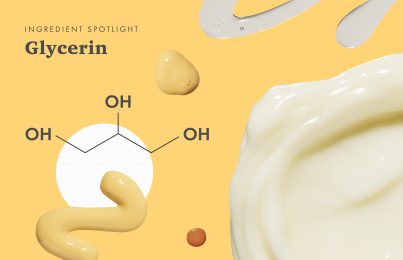As an esthetician with thirty-plus years of experience working hands-on with skin, I have always kept up with what is going on in the industry by attending tradeshows, being part of the skincare conversation online and taking cosmetic chemistry courses at UCLA. Based on what I’ve seen, these are the skincare trends I think you’ll start seeing more this year (and are worth paying attention to).
- 1. Water-Based Products
- 2. Skincare Ingredient: Propanediol
- 3. Two-Phase Double Cleansing Melting Cleansers
- 4. Skincare Ingredient: Bakuchiol
- 5. Clean Beauty Formulation Creeds
- 6. Products With 360-Degree Light Protection
- 7. Products That Affect the Skin’s Microbiome
- 8. Barrier-Repairing Products, Including Ones for Acne-Prone Skin
1. Water-Based Products
Lately, I’ve noticed that people are becoming more aware of the difference between dryness and dehydration. This is great to see because while it can be a confusing topic, it’s super important to understand which is affecting your skin since this will determine which products you should use. This is especially true for those with oily, combination and acne-prone skin (such as skin types #1, #2, #3 and #4). Dryness is a genetic skin type characterized by a lack of oil production. So, if your skin produces oil and you get breakouts (occasional or otherwise), chances are that tight, uncomfortable feeling is actually being caused by dehydration (AKA a lack of water). While it may be tempting to reach for heavy, emollient products best suited for dry skin types, these can clog your pores and should be avoided. Instead, focus on water-based products to plump and rehydrate your skin cells while rebuilding your moisture barrier.
Look for humectants such as hyaluronic acid, sodium PCA, glycerin and propanediol. Skin Recovery Lotion is a water-based moisturizer I formulated specifically for dehydrated, blemish-prone skin with a compromised moisture barrier (you can see its amazing effects in action in this post).
2. Skincare Ingredient: Propanediol
More companies are seeking to find alternatives to petroleum-derived ingredients, which are made from glycols (propylene glycol is a common example). That’s why I believe propanediol, a corn-derived solvent, will be a trendy ingredient in 2020. Propanediol is a humectant, meaning it helps the skin retain more moisture than water alone. It’s being used in products with high water content and is well-tolerated by even the most sensitive skin types.
Moisture Infusion Toner uses this ingredient in a high percentage to deeply infuse hydration and get the skin feeling exceptionally dewy and moist. It’s so good!
3. Two-Phase Double Cleansing Melting Cleansers
For those who wear a generous layer of makeup every day, it’s so important to ensure that it all gets properly removed. In years past, the double cleansing movement (you can read my opinion on double cleansing here!) has been on the rise, and this will only continue in 2020. Traditional double cleansing involves starting with an emollient oil-, lotion- or balm-based cleanser on dry skin, then massaging. This helps pull dirt, smog, and makeup pigments off the skin and starts breaking them down. Then, a second cleanser is used (usually a gel-based cleanser) to dissolve both the skin’s natural oils and any oil left behind by your balm cleanser. This step also removes any remaining traces of dirt or makeup. Once the gel-based cleanser is rinsed off, your skin should be properly cleansed.
The trend in 2020 will be a whole new category of cleansers known as “melting cleansers.” The idea behind melting cleansers is that you get all the benefits of a double cleanse with just one product. It starts off as a gel/cream, and then the texture of it changes as you massage it into the skin. Once you add water, the texture changes yet again to complete the cleanse.
4. Skincare Ingredient: Bakuchiol
No one doubts the effectiveness of retinol or its importance for those wanting to prevent the visible signs of aging. That said, retinol is not for everyone. Those with sensitive skin may have trouble tolerating it since retinol is an ingredient that can cause a lot of irritation. It’s is also not recommended during pregnancy or while nursing.
Enter Bakuchiol (trade name Sytenol® A). Bakuchiol is a plant-based ingredient that’s being touted as an alternative to retinol. This is because it behaves similarly to retinol in the skin and increases cell turnover. Bakuchiol is stable and well-tolerated even by sensitive skin types. From a product standpoint, it’s much easier to formulate with than traditional retinol. It’s also safe for all nine months of pregnancy, which is important because to get the true collagen-producing, skin-smoothing benefits, you want to use it on a consistent basis and not go on and off.
With all this hype, it’s important to keep in mind that the claims about the benefits of bakuchiol are based on only two studies. The benefits of retinol, on the other hand, have been studied for decades. That said, bakuchiol is a promising ingredient, and the most recent study suggests that using bakuchiol two times a day is as effective as using retinol (but not a retinoid) once a day. All in all, bakuchiol could be a great alternative for those who are pregnant or have very sensitive skin. It’s also completely vegan, which isn’t always the case with retinol. No doubt, we’ll be seeing this used a lot in 2020.
5. Clean Beauty Formulation Creeds
“Clean Beauty” is an increasingly popular term that generally implies that a product is free from certain ingredients, often referred to as “harsh chemicals” or “toxins.” There is no official commercial definition for the term “clean beauty” and it’s up to each brand’s interpretation. Safe to say, there has been an increased awareness of this concept.
We know that the beauty industry is fairly unregulated. In fact, it’s estimated that just two percent of the FDA’s budget is focused on cosmetics, and the rest goes to overseeing food and drug. In addition to this, the FDA has only banned eleven ingredients for use in cosmetics compared to the 1,328 ingredients that have been banned in the European Union. The U.S. is clearly behind in this area, and many skincare companies are taking matters into their own hands by omitting ingredients they deem potentially harmful to the skin or one’s overall health. What we will continue to see more of in 2020 is companies calling out their “free-from” ingredient lists. Many brands and retailers are also likely to start developing their own formulation creeds to share with consumers in an effort to evoke trust and transparency. At Renée Rouleau Skin Care, we have our own creed of what we use and what we avoid, and this year, we’ll be updating it a bit further.
6. Products With 360-Degree Light Protection
We’re constantly seeing more research focused on the damaging effects that all forms of light have on the skin. We have known for a long time that UV light given off from the sun is harmful to the skin, but now there is more awareness about how blue light (emitted by screens on mobile devices, computers, etc.) and heat-based infrared light are also damaging.
What we’ll be seeing in 2020 is products formulated with twenty-four-hour light protectors that help defend the skin against damage from all forms of light. This includes not only UVA and UVB but perhaps even ultraviolet light (UVC).
7. Products That Affect the Skin’s Microbiome
This past year, we’ve started to see a lot of products that include probiotics and learned a bit about how they impact the skin’s microbiome. In 2020, we’ll be seeing this even more, along with prebiotics and postbiotics.
On the surface of the skin is what is called the microbiome. The microbiome is made up of bacteria, fungi, and viruses. These microorganisms make certain chemicals that keep the skin healthy, in part by keeping the skin’s barrier intact. When it comes to skincare and the microbiome, the focus is mainly on maintaining a healthy balance of bacteria. There are thirty-six forms of bacteria that are part of what we call the P. acnes group. One of them causes acne but the other thirty-five are actually good for the skin.
There is a lot of research coming out about the microbiome, and we now understand there are three ways to work with the microbiome in skincare:
- The first is prebiotics. These are what the microbes eat in order to thrive. Ingredients like seaweed as well as some gelling agents of the polysaccharide nature are used for prebiotics. (Rapid Response Detox Toner uses a polysaccharide to encourage the skin to produce more “good” bacteria, which helps prevent the appearance of breakouts.) Think of prebiotics as food for good bacteria!
- The second is probiotics. This is where actual bacteria are put into products. This can be challenging to formulate as many preservative systems make it difficult for the bacteria to survive.
- The third is postbiotics. This is what you get after microbes die off. When probiotic bacteria die, a chemical reaction occurs. The by-products of this reaction can then be used in skincare products to benefit the skin’s microbiome.
The study of the microbiome is not slowing down, and this research will be incorporated into more skincare products in 2020.
8. Barrier-Repairing Products, Including Ones for Acne-Prone Skin
A damaged moisture barrier can be the underlying cause of so many common skin ailments. As more consumers start to understand this, there is a newfound awareness of the importance of using products with specific barrier-repairing ingredients. Have you ever used a heavy cream on your dry skin and didn’t feel like it actually did anything to improve moisture levels? This is probably because it was not formulated with ingredients that mimic the natural lipids found in your skin.
I’ve been seeing more clients than ever come to me with a damaged moisture barrier, mostly due to the access consumers now have to products that can break it down. Examples of these are facial scrubs, liquid acid toners, at-home peels, retinol, and prescription retinoids. People tend to overuse these types of products and put the skin in a vulnerable state that leads to increased sensitivity. (Take a look at my nephew’s skin and how I fixed his damaged moisture barrier.)
What we’ll be seeing in 2020 is more products marketed for their effectiveness at repairing the skin’s barrier. Here is a list of ingredients that work to do this:
- Borage Oil
- Bois De Rose Oil
- Canola Oil
- Caprylic/Capric Triglyceride
- Carrot Oil
- Ceramides
- Cranberry Oil
- Evening Primrose Oil
- Jojoba Oil
- Linoleic/Linolenic Acids (this is not an exfoliating acid)
- Niacinamide
- Phospholipids
- Phytosterols
- Safflower Oil
- Sesame Seed Oil
- Shea Butter
- Soybean Oil
- Sunflower Oil
- Sweet Almond Oil
- Squalane
- Tocopherol (vitamin E)
- Tocopheryl Acetate (vitamin E)
- Tocopheryl Linoleate (vitamin E)
- Tocopheryl Linoleate/Oleate (vitamin E)
While the ingredients on this list are very good at repairing a damaged barrier, many are also quite comedogenic and therefore not compatible with oily, acne-prone skin. What we’ll also see in 2020 is lightweight, breathable products formulated to improve the skin’s barrier without causing any blockage in the pores (I’m working on one such product right now!).
Read: How to Repair a Damaged Moisture Barrier
In summary, as consumers become increasingly more well-informed about skincare, we’ll keep seeing high-quality products with cutting-edge formulations. There is no shortage of skincare trends—but of course, many of them will come and go. You can also read my 2019 skincare trends list to see what I predicted last year. They were pretty spot on!
Celebrity Esthetician & Skincare Expert
As an esthetician trained in cosmetic chemistry, Renée Rouleau has spent 30 years researching skin, educating her audience, and building an award-winning line of products. Her hands-on experience as an esthetician and trusted skin care expert has created a real-world solution — products that are formulated for nine different types of skin so your face will get exactly what it needs to look and feel its best. Trusted by celebrities, editors, bloggers, and skincare obsessives around the globe, her vast real-world knowledge and constant research are why Marie Claire calls her “the most passionate skin practitioner we know.”





